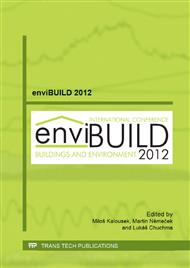p.113
p.117
p.121
p.125
p.129
p.133
p.139
p.143
p.147
Thermal Comfort Evaluation with Fireplace in Occupied Space
Abstract:
The solid fuel heaters are popular in Slovakia again, where about 50% of new freestanding homes have one. The classic fireplace, with a blazing fire open to the room as traditional symbol of comfort and security becomes with better building thermal insulation a primary rather than an occasional indulgence heat source. This paper reports the results of field measurement and simulation investigating the thermal comfort criteria in occupied space with fireplace heating system. The field study was performed in a small furnished living-room. The indoor surface temperatures were captured with infrared camera and the mean radiant temperatures were calculated by the ESP-r simulation tool. Thermal comfort prediction maps (PPD and PMV index) are presented to describe range of occupant comfort levels with mean air temperature, air velocity and clothing level variations. It was found that this system provide full area improved thermal climate only with high air temperature level. The study was limited to the case with no vertical air temperature distribution.
Info:
Periodical:
Pages:
129-132
Citation:
Online since:
January 2013
Authors:
Keywords:
Price:
Сopyright:
© 2013 Trans Tech Publications Ltd. All Rights Reserved
Share:
Citation:


